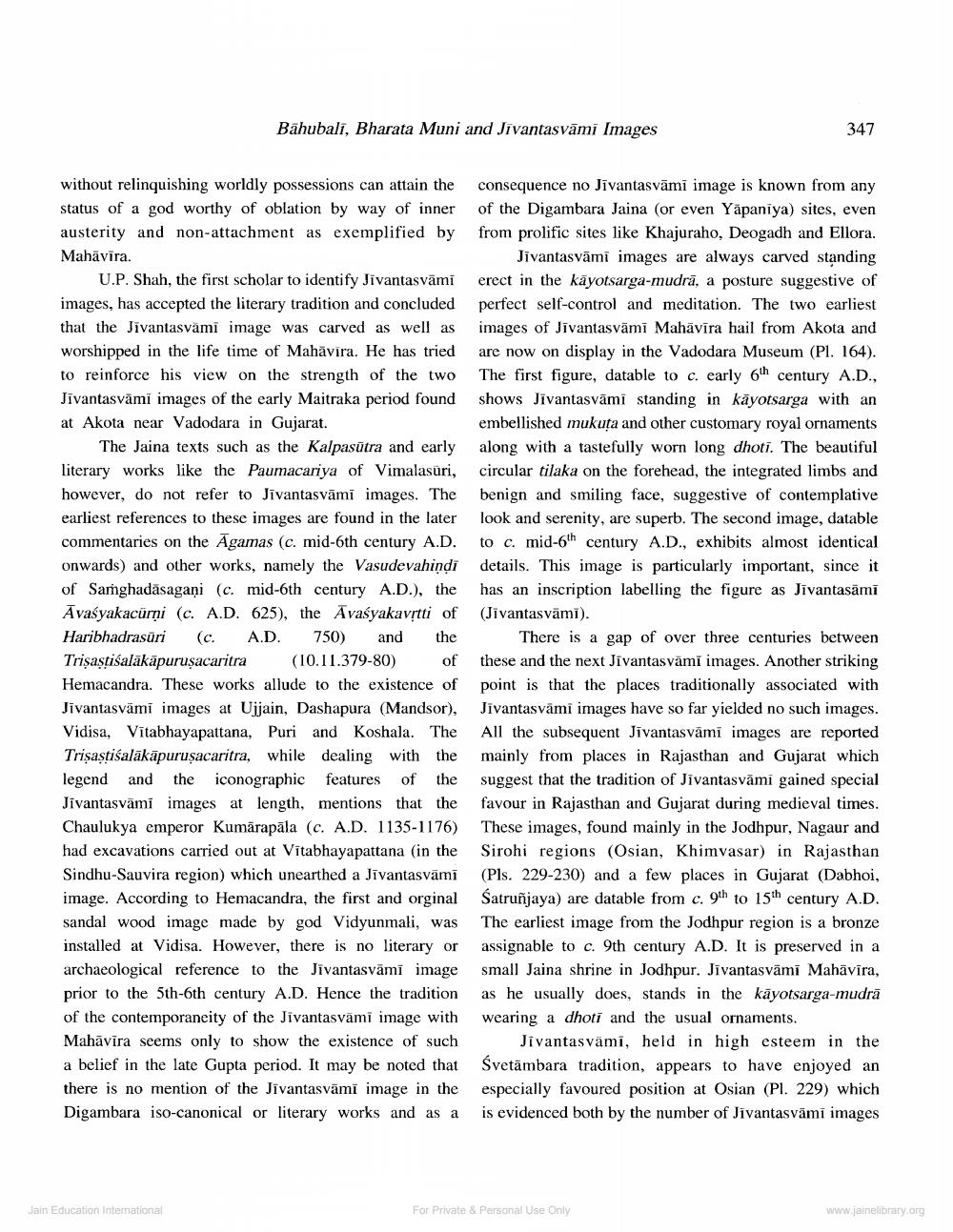________________
Bahubali, Bharata Muni and Jīvantasvāmi Images
347
without relinquishing worldly possessions can attain the status of a god worthy of oblation by way of inner austerity and non-attachment as exemplified by Mahāvīra.
U.P. Shah, the first scholar to identify Jivantasvämi images, has accepted the literary tradition and concluded that the Jivantasvami image was carved as well as worshipped in the life time of Mahāvīra. He has tried to reinforce his view on the strength of the two Jivantasvämi images of the early Maitraka period found at Akota near Vadodara in Gujarat.
The Jaina texts such as the Kalpasūtra and early literary works like the Paumacariya of Vimalasuri, however, do not refer to Jivantasvāmi images. The earliest references to these images are found in the later commentaries on the Agamas (c. mid-6th century A.D. onwards) and other works, namely the Vasudevahindi of Samghadāsagaņi (c. mid-6th century A.D.), the Avasyakacūrni (c. A.D. 625), the Avasyakavrtti of Haribhadrasūri (c. A.D. 750) and the
Trişastiśalākāpuruşacaritra (10.11.379-80) of Hemacandra. These works allude to the existence of Jivantasvāmi images at Ujjain, Dashapura (Mandsor), Vidisa, Vītabhayapattana, Puri and Koshala. The Trisastiśalākāpuruşacaritra, while dealing with the legend and the iconographic features of the Jivantasvāmi images at length, mentions that the Chaulukya emperor Kumārapāla (c. A.D. 1135-1176) had excavations carried out at Vitabhayapattana (in the Sindhu-Sauvira region) which unearthed a Jivantasvāmī image. According to Hemacandra, the first and orginal sandal wood image made by god Vidyunmali, was installed at Vidisa. However, there is no literary or archaeological reference to the Jivantasvāmī image prior to the 5th-6th century A.D. Hence the tradition of the contemporaneity of the Jivantasvami image with Mahāvīra seems only to show the existence of such a belief in the late Gupta period. It may be noted that there is no mention of the Jivantasvāmi image in the Digambara iso-canonical or literary works and as a
consequence no Jivantasvāmi image is known from any of the Digambara Jaina (or even Yapaniya) sites, even from prolific sites like Khajuraho, Deogadh and Ellora.
Jivantasvāmi images are always carved standing erect in the käyotsarga-mudrā, a posture suggestive of perfect self-control and meditation. The two earliest images of Jīvantasvāmī Mahāvīra hail from Akota and are now on display in the Vadodara Museum (Pl. 164). The first figure, datable to c. early 6th century A.D., shows Jivantasvāmi standing in käyotsarga with an embellished mukuta and other customary royal ornaments along with a tastefully worn long dhoti. The beautiful circular tilaka on the forehead, the integrated limbs and benign and smiling face, suggestive of contemplative look and serenity, are superb. The second image, datable to c. mid-6th century A.D., exhibits almost identical details. This image is particularly important, since it has an inscription labelling the figure as Jivantasāmi (Jivantasvāmī).
There is a gap of over three centuries between these and the next Jivantasvămî images. Another striking point is that the places traditionally associated with Jivantasvāmi images have so far yielded no such images. All the subsequent Jivantasvāmi images are reported mainly from places in Rajasthan and Gujarat which suggest that the tradition of Jivantasvāmi gained special favour in Rajasthan and Gujarat during medieval times. These images, found mainly in the Jodhpur, Nagaur and Sirohi regions (Osian, Khimvasar) in Rajasthan (Pls. 229-230) and a few places in Gujarat (Dabhoi, Satruñjaya) are datable from c. 9th to 15th century A.D. The earliest image from the Jodhpur region is a bronze assignable to c. 9th century A.D. It is preserved in a small Jaina shrine in Jodhpur. Jivantasvāmī Mahāvīra, as he usually does, stands in the kāyotsarga-mudrā wearing a dhoti and the usual ornaments.
Jivantasvämi, held in high esteem in the Svetāmbara tradition, appears to have enjoyed an especially favoured position at Osian (Pl. 229) which is evidenced both by the number of Jivantasvāmī images
Jain Education Intemational
For Private & Personal Use Only
www.jainelibrary.org




